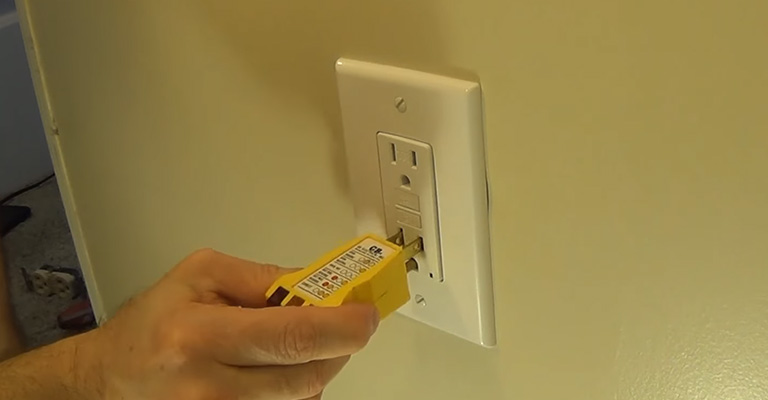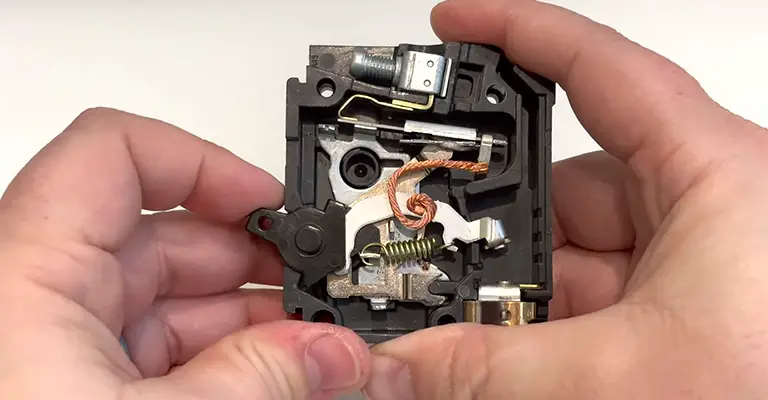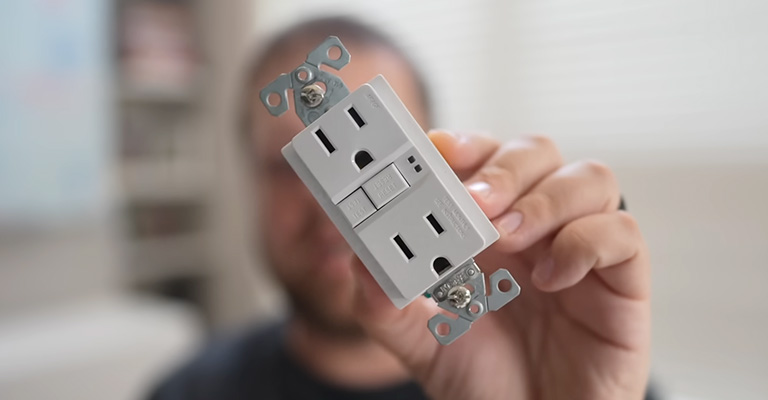GFCI outlets are designed to protect against ground faults, which occur when there is a current leakage to the ground, such as in the case of a faulty appliance or damaged wiring.
They are commonly installed in areas where there is a higher risk of electrical shock, such as bathrooms, kitchens, outdoor areas, and near water sources.
AFCI protection, on the other hand, is designed to detect and prevent arcing faults, which can occur when there is a loose or damaged wire that produces sparks or arcs.
AFCI protection is typically required for circuits that power bedrooms, living rooms, and other living spaces to reduce the risk of fire caused by arc faults.
It is important to have both AFCI and GFCI circuits in your home, but can GFCI outlets be installed on an AFCI circuit? Is it going to provide greater protection?
Can You Put a GFCI Outlet on an AFCI Circuit?
Yes. It is possible to install a GFCI outlet on an AFCI circuit. The two circuits are compatible with each other. You may do this if your specific setup leaves you with no other choice or if you have some particular reason to do so.
Due to the ability of AFCI to provide high-level protection to modern electrical wiring systems, it is possible to install GFCI outlets on an AFCI circuit.
There is a difference between an AFCI and a GFCI in terms of their functions. Fires can be ignited by arching faults which can occur in branch circuit wiring, which is why AFCI outlets are used.
AFCI protects against arcs in branching circuits. Electrical shocks can be deadly or harmful if there is an electrical leakage inside the ground fault. GFCIs protect people from such shocks.
It is usually the GFCI that prevents electrocution from connected loads. Therefore, it is important to use both carefully together.
If you are unsure if your outlets are compatible, you should seek advice from an experienced installer.
AFCIs and GFCIs Can Be Used Together

GFCI and AFCI on a single circuit are explicitly stated and confirmed in the 2014 edition of the NEC. GFCI and AFCI should be installed in all rooms of new houses beginning with this edition.
It is possible to feed GFCI receptacles from AFCI circuit breakers since the latter provide protection for any modern wiring system.
Having said that, I am aware that every case is different. GFCI protection will be needed in a room where the arc fault breaker wiring is being extended, or vice versa.
GFCI circuits can be connected to arc fault breakers without damaging them, so don’t worry about damaging the breakers.
What Is The Purpose Of An AFCI Outlet And A GFCI Outlet?

Electrical fires that occur because of arcs can be prevented by AFCI outlets, which are intended to prevent arcs from causing electrical fires. By detecting abnormal situations, these outlets can distinguish between normal and dangerous arcs.
In addition to interrupting power when an arc fault is detected downstream from where the receptacle is installed, they also interrupt power within items that are plugged in. Code-compliant homes are equipped with AFCIs. All new residential construction requires them.
There is also a need for AFCI outlets in certain areas of a house or building, such as bedrooms, living rooms, and more, since fires can start anywhere in the home. The National Electrical Code (NEC) requires them in these areas.
As opposed to this, GFCI outlets protect people from severe and sometimes fatal electrical shocks by detecting ground faults. A GFCI is different from a fuse because it is integrated into the outlet.
GFCI outlets monitor the amount of power going to appliances when they are plugged in. GFCIs detect any interruption in current and immediately cut the power when they detect it.
What Are The Disadvantages Of Using A GFCI Outlet On An AFCI Circuit?
Your question about whether GFCI outlets can be installed on AFCI circuits has already been answered. The use of GFCI outlets on AFCI circuits is safe, but there are some disadvantages.
- When you install a GFCI outlet on an AFCI circuit without a GFCI breaker, it can cause problems. Even in the presence of an outlet, the GFCI component is not protected. A ground fault will still cause some damages.
- Another potential danger occurs when a GFCI outlet is present on an AFCI circuit, but no GFCI outlets are present in the other rooms. Again, this type of connection is futile since ground faults cannot be prevented.
Where are AFCI Outlets Required? Does Every Outlet Need to be AFCI?
AFCI outlets have been described in the previous pointer, now let’s discuss the areas where they are needed.
A house must have AFCI outlets according to the National Electrical Code (NEC). It is quite likely that a fire will occur when electrical systems are present.
Hence, AFCI outlets are needed in certain areas because people spend more time there than in other parts of the house. AFCI outlets are necessary in the following areas.
- Hallways and closets
- Laundry areas
- Bedrooms
- Finished basements
- Common rooms
- Kitchens
If you are wondering if all outlets need to be AFCI, then no, they do not all need to be.
Which is Safer: an AFCI or GFCI?
As such, it is difficult to determine which one is safer because they both serve different purposes. GFCI outlets prevent shocks and AFCI outlets prevent fires. That’s the difference between the two.
As a breaker, the AFCI is installed, and as a receptacle, the GFCI is installed. Breakers protect the entire circuit, while receptacles protect downstream if the load is connected downstream.
Find Dual-Function AFCI/GFCI Breakers Instead
So, you won’t have to worry about getting a sub-optimal setup or asking, “Can I use AFCI instead of GFCI? ”
In your local store or online, you can find combination AFCI/GFCI breakers UL 489 or UL 1699.
By investing in them, homeowners can avoid the hassles associated with replacing receptacles in rooms that require AFCI or GFCI protection.
In case you can’t find them locally, ordering them online is a good idea, especially if you are renovating or building a new house.
With both systems installed, your home will benefit from the protection offered by both and will be practically future proofed against any updates to NEC recommendations in the future.
Prior to now, NEC wording only required dual GFCI and AFCI protection in kitchens and laundry rooms; now, they’re also required in bathrooms.
Considering all things considered, new homeowners are actually lucky since, around ten years ago, people only thought about how convenient combined GFCI/AFCI breakers would be. It’s a reality now!
Final Words
GFCI receptacles should not be connected to AFCI circuits or breakers. For you to avoid having issues with these two altogether, I recommend taking the following steps:
Consider installing an AFCI/GFCI main breaker instead if you would like to save yourself from needless headaches.
If you plan to make major changes to your home’s circuits, outlets, or breakers, stay updated on the latest NEC recommendations.








